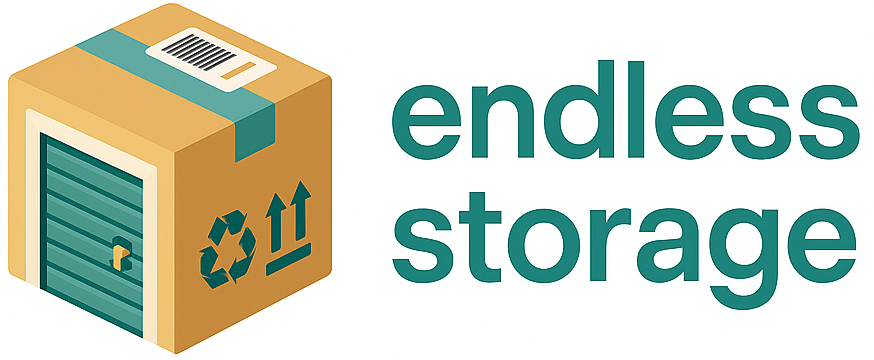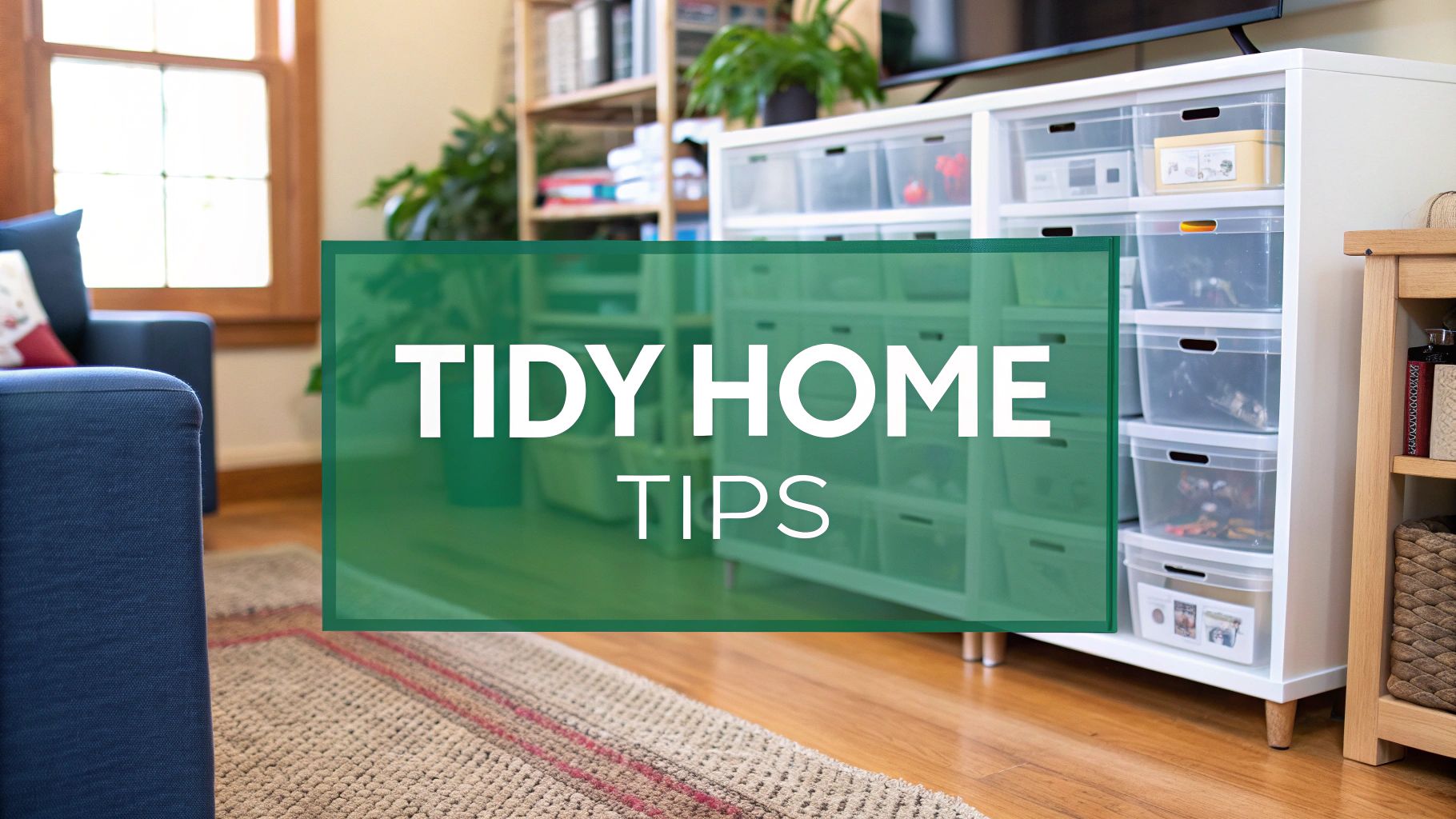The secret to starting decluttering is to think small. Find one tiny, manageable spot—a single drawer, one shelf—and give yourself no more than 15 minutes to clear it completely. This quick win builds instant momentum, making the bigger project feel much less intimidating. It's not about finishing all at once; it's about taking that first satisfying step.
Starting Your Decluttering Journey Without Stress
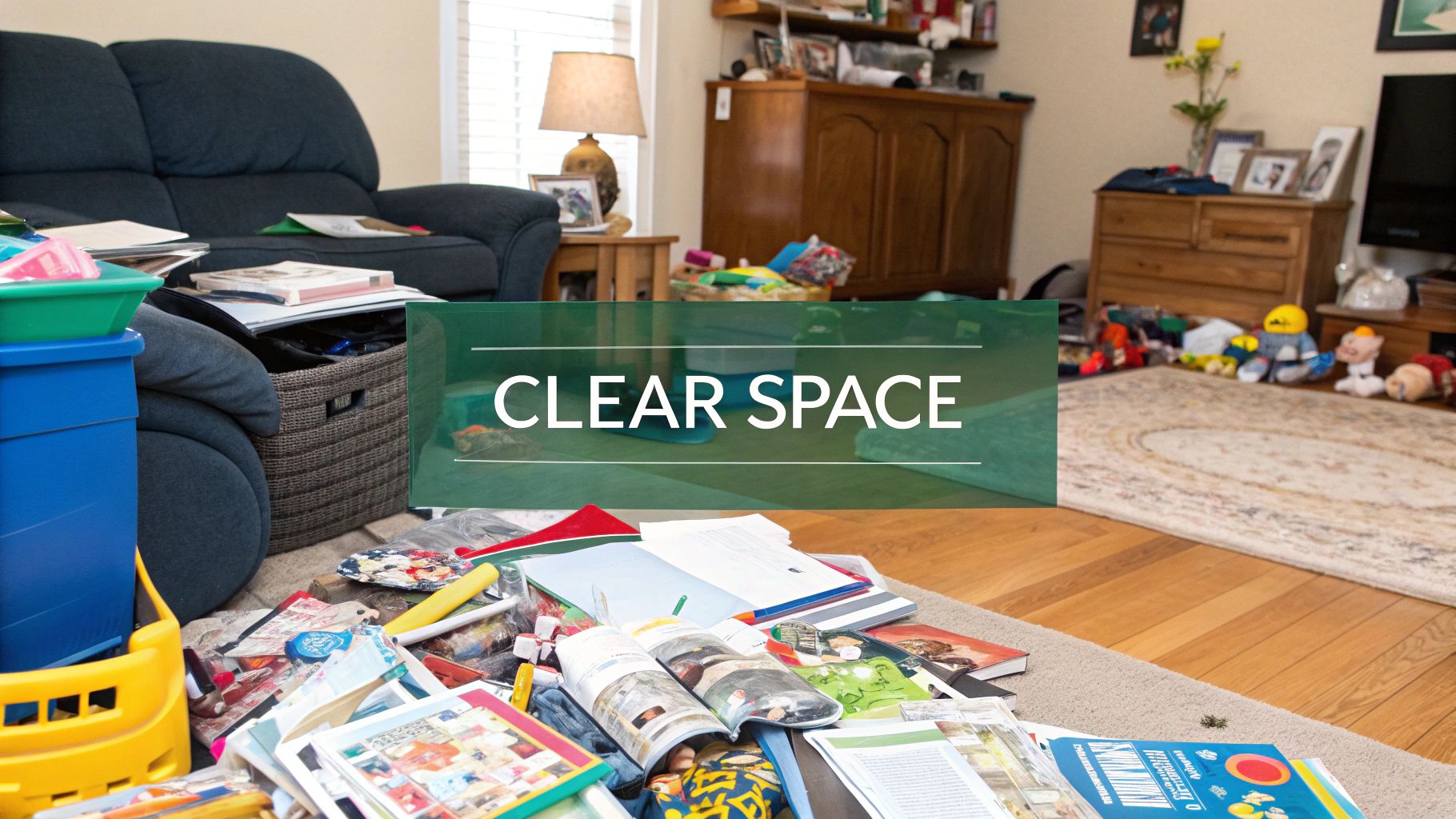
If the very thought of decluttering your home makes you feel paralyzed, you're not alone. The real problem isn't usually the stuff itself, but the mental load it represents. We see a messy room and our brains flood with a mountain of decisions, memories, and chores. It's no wonder so many of us just shut down and walk away.
This feeling is incredibly common. In fact, 54% of Americans feel overwhelmed by the sheer amount of clutter in their homes. When you learn that the average U.S. household contains around 300,000 items, it's easy to see why the task feels so monumental. You can find more stats on household clutter over at bookcleango.com.
Shift Your Mindset From Monumental to Manageable
The real trick to learning how to declutter is to completely reframe the process. Ditch the idea of a massive, weekend-long purge. Instead, think of it as a series of small, satisfying "mini-projects."
Your goal isn't to create a magazine-perfect home overnight. Your goal is simply to make one tiny space better today.
This could be:
- The kitchen junk drawer.
- The top of your nightstand.
- A single messy shelf on a bookcase.
- That dreaded pile of mail on the counter.
When you focus on one small, contained area, you give yourself a clear and achievable finish line. Knocking out that one little task delivers a powerful hit of accomplishment. It builds the confidence and motivation you need to tackle the next small area, and then the one after that. This is how you turn dread into momentum.
The most effective way to begin is by focusing on one micro-goal. The objective is not to declutter the house; it’s to clear the junk drawer. That small victory is the fuel for your entire journey.
Your First Three Decluttering Actions
To get you started right now, I've put together a quick-start table with three simple actions you can take in the next 10 minutes. This isn't about agonizing over what to keep; it's about creating visible progress almost instantly.
Your First Three Decluttering Actions
See how easy that was? This process of starting small isn't just about tidying up—it's about fundamentally changing your relationship with your space and your belongings. As you continue, you’ll start to discover the many life-changing benefits of decluttering your home that go far beyond just having a clean house.
The Four-Box Method: A Practical Workflow
Trying to declutter a room without a solid plan can backfire, fast. Before you know it, you’re just moving piles from one corner to another, making an even bigger mess than when you started. That’s not progress; it’s just rearranging the chaos.
If you really want to get a handle on your space, you need a system. A system that takes the guesswork out and forces you to make clear, decisive choices. This is exactly why professional organizers swear by the Four-Box Method. It’s a refreshingly simple, yet incredibly powerful, way to turn any chaotic room into a place of order.
The magic is in its straightforward approach. You just need four boxes—or even just four designated spots on the floor—and label them: Keep, Donate/Sell, Trash, and Relocate. That's it. From here on out, every single item you touch goes into one of those four categories. No exceptions and absolutely no "maybe" piles.
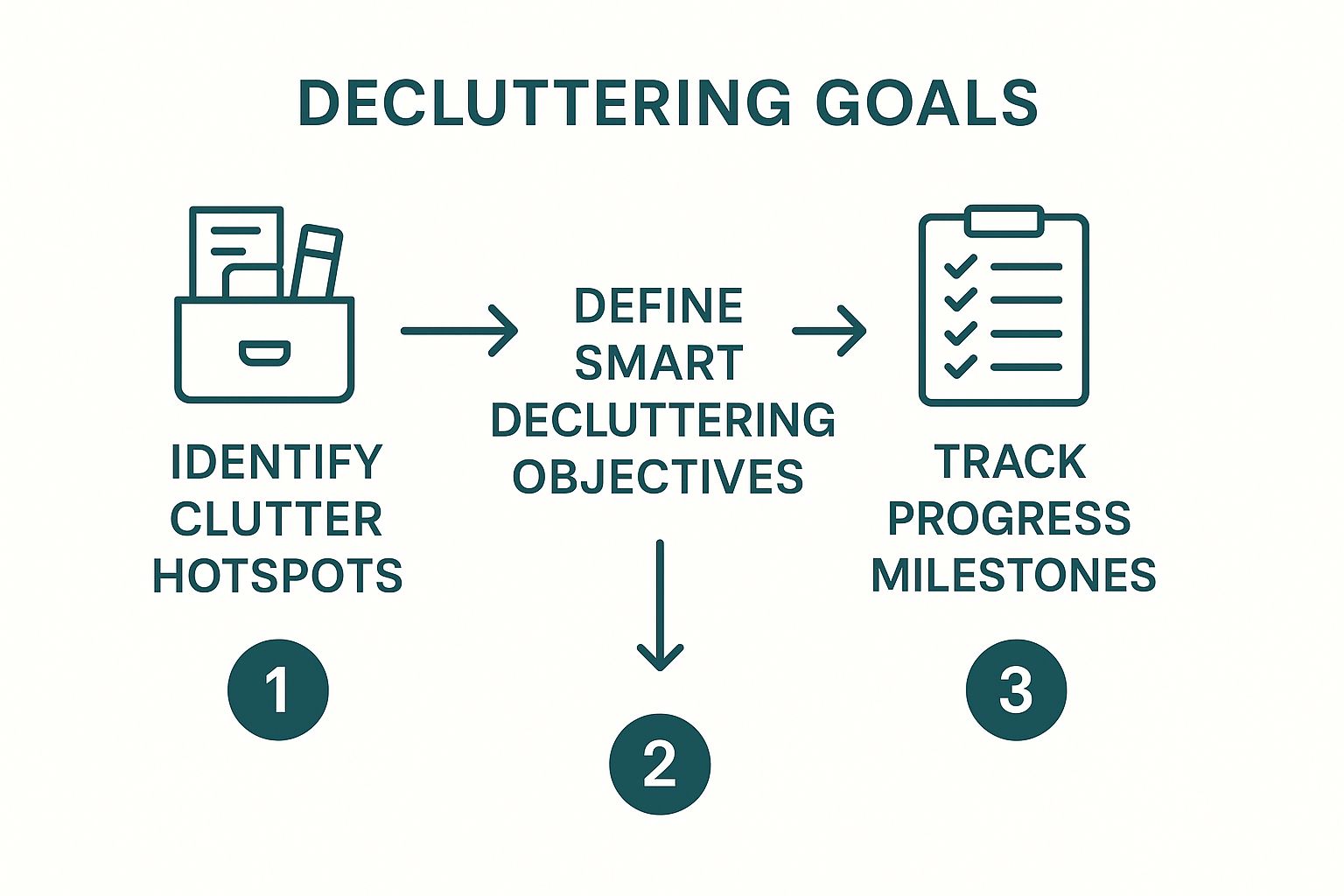
As you can see, successful decluttering isn't about diving in headfirst. It starts with a clear strategy, from identifying your trouble spots to setting concrete goals and, most importantly, celebrating your progress.
Defining Your Categories
The key to keeping your momentum is making quick decisions. Let's break down what belongs in each box.
Keep: This is for items you actively use, genuinely love, or are legally required to hold onto. We’re talking about the kitchen gadget you used last week, not the one you think you might use someday. For clothes, stick to what you've worn in the past year and what truly fits your current lifestyle.
Donate/Sell: Anything in good, usable shape that you simply don’t need anymore belongs here. That bread maker you got as a wedding gift and never unboxed? The stack of novels you’ve already finished? Give them a chance at a second life with someone new.
Trash: This one is for anything broken, expired, stained, or otherwise unusable. It's time to be ruthless. Old receipts, dried-up pens, and socks missing their partners have served their purpose. Letting them go is an easy win and feels great.
Relocate: This box is the unsung hero of decluttering. It’s for all the things that have a home in your house… just not in the room you’re working on right now. Think of the coffee mug on your nightstand that belongs in the kitchen, or the kids' toys that have slowly migrated into the living room.
Making Tough Decisions on the Spot
The biggest hurdle for most people is the "just in case" item. What do you do with that expensive dress you haven't worn in five years? Or the supplies for a hobby you abandoned ages ago?
When you're stuck, try flipping the script. Instead of asking, "Could I use this again someday?" ask yourself, "If I were shopping right now, would I buy this?" This simple mental shift usually provides all the clarity you need.
Once you’ve sorted an area, the final step is to take immediate action on your boxes. Put the Relocate items back where they belong. Take the Trash bag straight out to the bin. Put the Donate/Sell box in your car so it’s ready for your next errand.
Finally, find a permanent, logical home for everything in your Keep box. Don't skip this part! It's what prevents your newly-sorted items from becoming the next pile of clutter and solidifies all the hard work you've just put in.
Executing a Room-by-Room Decluttering Plan
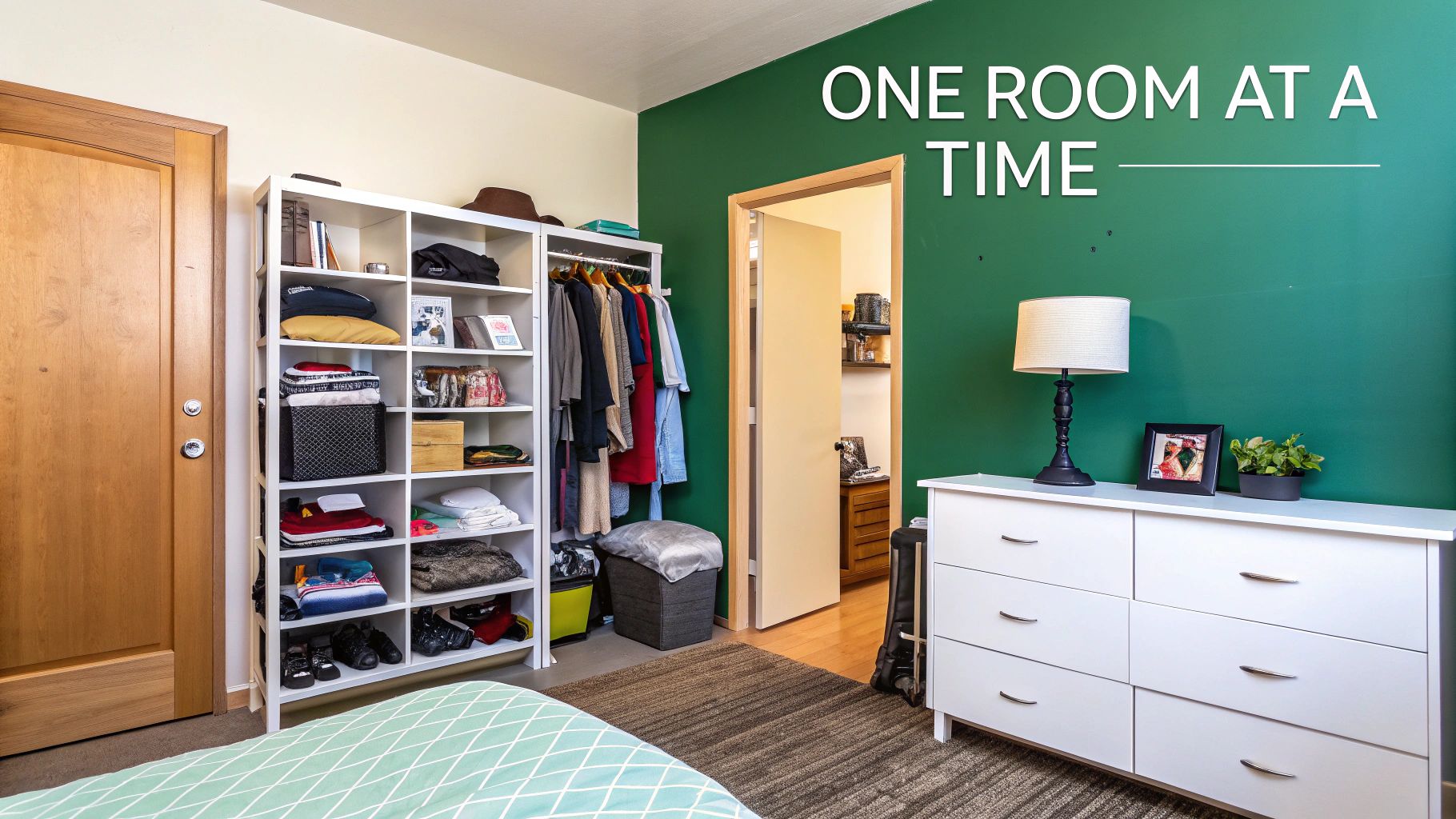
Alright, you’ve got your system down. Now for the fun part: putting it into action. But where on earth do you start? Staring at the whole house at once is a surefire way to feel overwhelmed and quit before you even begin.
The real secret to learning how to declutter for good is to divide and conquer. A room-by-room plan doesn't just make the project manageable; it creates visible, motivating progress. Each cleared space is an achievable win that fuels you for the next one.
Forget diving headfirst into the garage or the attic—those are what I call clutter black holes. Instead, we’re going to start with high-impact, low-effort areas. Pick a room that’s relatively easy to clear out but whose transformation you'll see and feel every single day. This is how you build the momentum you’ll need for the tougher spaces down the road.
Prioritizing Your Battle Plan
The key is to start with rooms that give you a quick victory and make a real difference in your daily life. This targeted approach lets you feel the benefits right away.
- The Bathroom: This is the perfect place to start. It’s small, the storage is limited, and most items have obvious expiration dates. Toss that expired makeup, old medication, and those nearly-empty bottles of conditioner. It’s an easy, guilt-free purge.
- The Entryway or Hall Closet: This little space sets the tone for your entire home. Clearing out shoes you haven’t touched in years, old coats, and that pile of junk mail instantly makes your home feel more welcoming and under control.
- The Living Room: Focus on the surface clutter here first. Gather up the piles of magazines, find a home for all the remote controls, and put away anything that doesn't belong. A clear living room is a powerful visual reminder of the peace that comes from a tidy home.
This methodical approach isn't just a personal preference; it's driving a huge industry. The professional organizer market was valued at a staggering USD 12.26 billion in 2025 and is only expected to grow as more people look to reclaim their homes from clutter.
The goal isn't just to empty a room; it's to reclaim its purpose. A decluttered bedroom should promote rest, a clean kitchen should inspire cooking, and an organized living room should encourage relaxation.
Tackling Specific Clutter Culprits
Once you've built up some confidence with those easy wins, you're ready to move on to the more challenging areas. Every room has its own common clutter magnets, but with the right strategy, you can tackle them all.
The Kitchen Countertops
Kitchen counters seem to attract anything and everything that doesn't have a designated home. The trick here is to be ruthless about what really deserves to be on display.
- Small Appliances: If you don't use it at least weekly, it doesn’t get to live on the counter. That stand mixer or giant air fryer can be stored in a cabinet until you need it.
- Mail and Papers: Create one—and only one—spot for incoming paper. A small wall file or a single tray works perfectly. Make a habit of processing it daily.
- Utensil Crocks: Let’s be honest, do you really need 20 spatulas within arm's reach? Probably not. Keep your top 3-4 most-used tools out and store the rest in a drawer.
The Bedroom Closet
A chaotic closet can easily start your day with a dose of stress. This is often a major project, but breaking it down into smaller tasks makes it completely doable. If you're tackling this as part of a bigger life event, like a move, having a clear plan is essential. Our guide on essential methods to declutter before moving can help you prepare.
For some more specialized advice on whipping your wardrobe into shape, these 8 essential closet cleanout tips offer fantastic, practical advice for creating a closet you actually love opening. By sticking to this room-by-room strategy, you'll ensure you’re always making forward progress, turning a daunting task into a series of satisfying accomplishments.
Alright, we’ve cleared the easy stuff. Now it’s time to face the two titans of clutter: sentimental keepsakes and that never-ending mountain of paper. This is where decluttering gets personal. These aren't just things; they're tied to our memories, our obligations, and a whole lot of anxiety. To get through this, we need a different kind of strategy—one with more heart and less brute force.
When it comes to sentimental items, the goal isn't to purge your past. It’s about celebrating it in a way that doesn't suffocate your present. The simple "keep" or "toss" mentality just doesn't work here; it's a recipe for guilt and getting stuck. Instead, think of yourself as a curator of your own life story, choosing which pieces deserve a prime spot in your home.
Handling Sentimental Belongings with Care
First things first: give yourself permission to let some things go. You are not defined by your grandmother's forgotten china set or a box of old concert t-shirts. The memories are what you truly value, and thankfully, we have ways to preserve them without sacrificing precious living space.
Try these gentler approaches:
- Create a Memory Box: Pick out one or two beautiful boxes. These are your designated memory keepers. The finite space forces you to be selective, ensuring you only save the most powerful items—that first baby blanket, a bundle of love letters, a few truly cherished photos.
- Go Digital: Take a high-quality photo of items that pull at your heartstrings but you just don’t have room for. A picture of your dad’s old, worn-out toolbox can spark the exact same warm feeling as the real thing. Then, you can pass the actual toolbox on to someone who will put it to good use.
- Incorporate, Don't Store: Why hide beauty in a dusty box? Use that quilt from your aunt as a cozy throw on your sofa. Frame a piece of your child's early artwork instead of letting it get buried in a folder. Give these meaningful items a new life out in the open.
The most freeing realization is that you can cherish a memory without having to store the artifact. Your home is for living in now, not for housing a museum of your past.
This can be one of the most difficult parts of the decluttering journey. For a deeper dive, our complete guide on how to declutter sentimental items walks you through a compassionate, step-by-step process.
Winning the War on Paper Clutter
If sentimental items are a battle for the heart, paper clutter is an all-out assault on your peace of mind. The constant stream of bills, junk mail, school flyers, and old statements creates visual noise and a low-grade hum of stress. The only way to win is with a simple, sustainable system.
First, stop the flow at the source. Be ruthless. Unsubscribe from every catalog and junk mail list you can. Switch to paperless billing and statements for every single account—it’s a five-minute job that will save you hours of sorting down the road.
Next, set up a simple "command center" for any paper that still gets through. This is not a pile. It’s a single, designated spot—like a sleek wall file or a single tray on your desk. Get into the non-negotiable habit of processing it daily. It takes less than two minutes and stops a molehill from ever becoming a mountain. Your system only needs three destinations: Action (bills to pay, forms to sign), To File (tax docs, contracts), and the most satisfying one of all—the Recycling Bin. By dealing with paper the moment it enters your home, you finally reclaim control over the administrative chaos of life.
Building Habits To Maintain A Clutter-Free Home
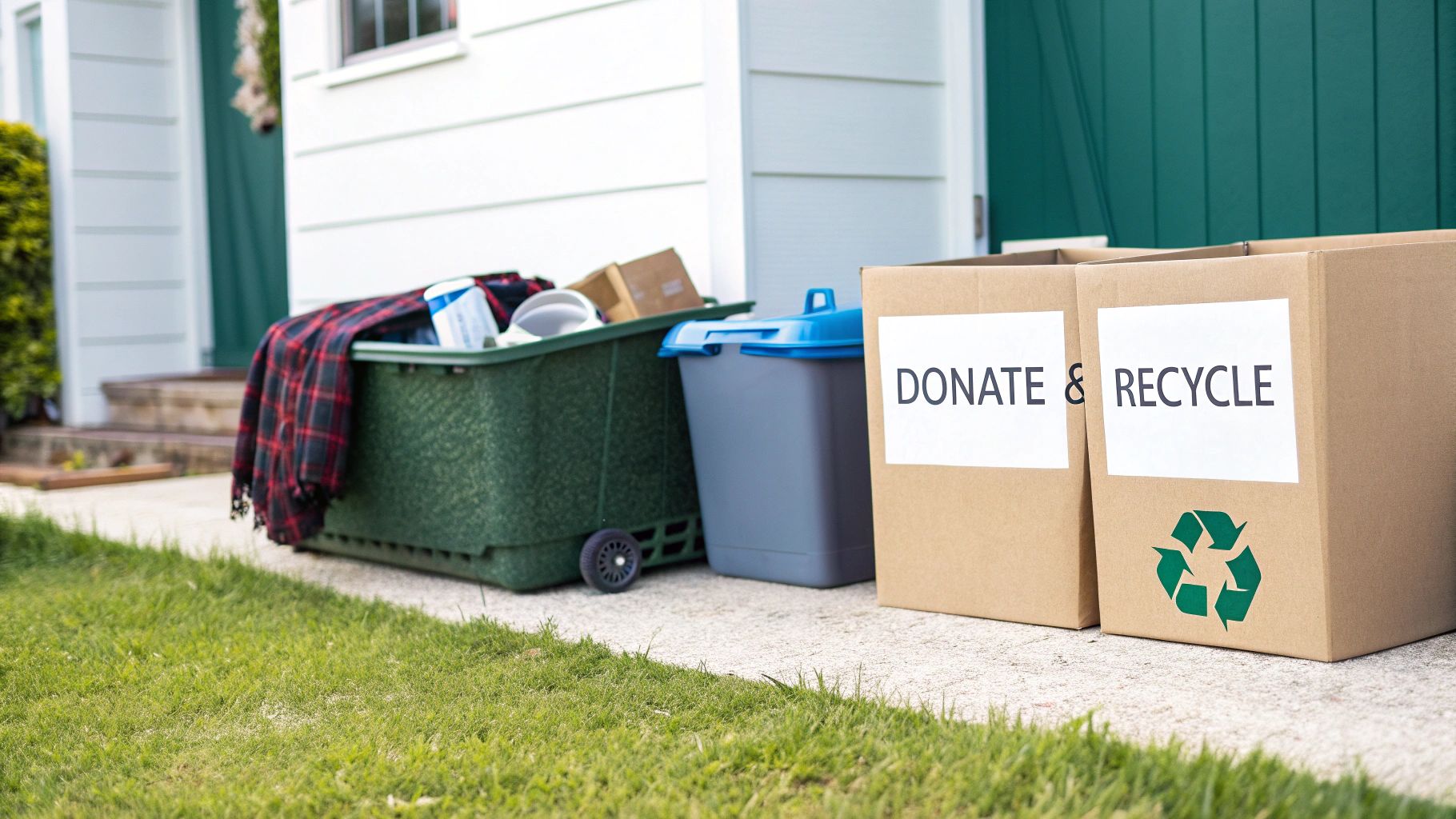
You did it. You went through the whole process, and your home is finally decluttered. That’s a huge win, but here’s the tough truth I’ve learned over years of helping people organize: the purge is just the beginning. The real challenge is keeping the clutter from creeping back in.
Without a few solid habits, all that hard work can unravel surprisingly fast. The goal isn't to be in a constant state of tidying up. It's to build a lifestyle where order is the default. This happens when you swap out old, clutter-creating behaviors for new, organizing ones. Think of it as creating a simple framework that stops messes before they even start.
Adopt The One-In, One-Out Rule
If you only adopt one new habit, make it this one: the one-in, one-out rule. It’s a beautifully simple concept that works for everything from shoes and books to kitchen gadgets. When you bring something new home, something similar has to go.
Just bought a new sweater? Great. Now, pick an old one to donate. This single action prevents your closets and drawers from getting overstuffed ever again. It forces you to be more intentional about what you buy and more aware of what you already own. A huge part of this is also being mindful of the packaging and waste new items bring, which is why it helps to learn how to reduce plastic waste for a cleaner home.
Create Homes For Everything
Here’s a secret: clutter happens when things don't have a place to live. An item without a designated "home" will always end up on the counter, the floor, or the dining room table. The fix? Give every single thing you own a permanent, logical spot.
It sounds like a lot, but it’s really about common sense:
- Keys get tossed in a specific bowl by the door.
- Mail is immediately sorted at a small desk or filing area—no more piles.
- The TV remotes live in a basket on the coffee table. Always.
When everything has a home, cleaning up isn't a project anymore. It’s just a quick, mindless process of putting things back where they belong.
Think about this: Americans spend a staggering $2.7 billion a year replacing things they can’t find. Even worse, the average person wastes 2.5 days annually just searching for lost items. Giving your belongings a home doesn't just cut clutter; it saves you serious time, money, and frustration.
This system also makes it incredibly easy to get the whole family on board. When everyone knows where things are supposed to go, keeping the house tidy becomes a shared and manageable responsibility. For more ideas on building systems that last, check out our guide on the top methods to declutter your home for good. These small habits are what truly separate a one-time clean-up from a permanently clutter-free life.
Common Decluttering Questions Answered
Even with the best game plan, decluttering has a way of serving up tricky questions that can stop you cold. Pushing through these mental roadblocks is what separates a half-finished project from a truly transformed space. Let’s walk through some of the most common hurdles I see people face.
The biggest one? The fear of getting rid of something you might need later. This “what if” anxiety is completely normal, but it can be paralyzing. It’s what causes us to keep things we haven’t touched in years, all based on pure speculation. The trick is to give yourself a safety net so you feel empowered to let go.
I always recommend the "purgatory box." It's a simple but incredibly effective tool. For any item you're on the fence about, pop it in the box, seal it up, and write a date on it six months from now. Then, put it somewhere out of sight. If you haven't needed—or even thought about—what's inside by that date, you can confidently donate the whole box without even opening it. It's a risk-free way to test whether you really need something in your life.
How Long Does This Actually Take?
The honest answer: it depends. How long it takes to declutter your home is based on its size, how much stuff you have, and the time you can realistically set aside. Instead of getting fixated on a big, scary deadline, shift your focus to consistency.
A much better approach is to set a small, consistent time goal. Committing just 20 minutes a day will make a huge difference over a few months. Trying to tackle it all in one weekend just leads to burnout and a bigger mess than when you started.
Remember to celebrate the small wins along the way. Clearing out even one drawer or a single room is a major accomplishment that deserves a pat on the back before you move on.
Should I Organize First or Declutter First?
This one has a firm, non-negotiable answer: always declutter first. I can't stress this enough. Trying to organize clutter is a deeply frustrating and pointless exercise. It's like trying to arrange furniture in a room that’s already packed to the ceiling with unopened boxes—it’s just not going to work.
Organizing is about finding the perfect home for the items you actually need, use, and love. You simply can't design an effective system when you’re wrestling with an avalanche of things that don't even belong there in the first place.
- Decluttering is the purge—the act of removing what is no longer serving you.
- Organizing is the arrangement—the process of creating a logical, accessible home for what remains.
Purge first. You'll be amazed at how simple and intuitive the organizing part becomes afterward. For a deeper dive into these kinds of roadblocks, check out our full guide covering more decluttering questions answered to help you keep the momentum going.
When your "Keep" pile still feels a bit too large for your home, Endless Storage offers the perfect middle ground. Store your seasonal items, precious keepsakes, and "maybe later" belongings with our simple, box-by-box service. It’s the easiest way to keep your home feeling peaceful and clear. Explore your storage options today.
Frequently Asked Questions
Unveiling the Secrets to Effortless Storage
Endless Storage is available nationwide. You pick a plan, tell us where to pickup, and we'll send a UPS van to collect, whichever state you're in.
Your shipping label will be sent to your email within a few minutes, if not instantaneously. It can also be accessed through your customer profile.
Your box will be shipped to one of our climate controlled self storage facilities in our closest self storage facility. Our manager will accept your package, notify you that your box has been received, and securely stored. Only our managers will have access to Endless Storage boxes.
Email us at admin@endless-storage.com click to live chat with us, or send us a message below.
Never! We're committed to transparent pricing with no surprises. You'll lock in your rate with no hidden fees and no long-term contracts.
Fast access guaranteed! Your boxes will arrive at your doorstep within 48 hours of requesting them back. Need to check on delivery? We provide tracking information for complete peace of mind.
Totally flexible! Store month-to-month with no long-term commitment and cancel anytime.
Everything's online! Use your account dashboard to:
• Set up automatic monthly payments
• Request box returns
• Update your address
• Order additional boxes
• Track shipments
Your boxes are insured up to $100 each. Our customer service team will help you file any necessary claims and resolve issues quickly.
Don't worry – we'll email you right away if there's a payment issue. Your items stay safe, though you may have temporary service interruption or late fees until payment is resolved.
When you request our free storage kits, you'll have 30 days to send in your boxes to activate your 3 months of free storage. Think of it like starting a gym membership – your activation window begins when you receive your kits, and your full free trial begins once you send in your first box. During your free months, you'll experience our complete storage service at no cost.
Your 30-day activation window begins when you receive your storage kits. We'll send you an email confirmation when your kits are delivered, marking the start of your activation period.
If you haven't sent any boxes for storage within your 30-day activation window, your free trial will expire and we'll begin charging the regular monthly rate of $9.99 per box. This helps ensure our storage kits go to customers who are ready to use our service.
A box costs $9.99 per month to store (plus sales tax). This price includes free shipping for standard boxes under 50 lbs. and smaller than 16"x16"x16"
Log into your Endless Storage account, locate the box you would like returned, and simply click Return My Box.
Yes, each box stored with us is insured for up to $100 throughout transit as well as the duration of storage within our facilities.
Your box will be at your doorstep within 48 hours of you requesting it back.
Store 10+ boxes? We'll pick them up for free! After your purchase, we'll contact you to schedule a convenient pickup time and arrange UPS collection.
We trust UPS with all shipments, and every box includes $100 insurance coverage. You'll receive tracking information to monitor your items' journey.
Yes! Visit any of our locations by appointment. Just bring a photo ID matching your customer profile.
For everyone's safety, we can't store hazardous materials, firearms, or perishables. All items must fit within our standard boxes.
It's easy! Order your storage kit online, and we'll ship it to you within 1-2 business days. Your shipping labels will be emailed instantly and available in your account.
We're here to help! Email us at admin@endless-storage.com, use our live chat, or send us a message through your account.
To cancel your storage service with Endless Storage, please email your cancellation request to admin@endless-storage.com. Our team will process your request within 2 business days and confirm your cancellation via email.
We understand packing takes time. However, to maintain your free trial benefits, you'll need to send at least one box within the 30-day activation window. If you need more time, you can always start with one box to activate your trial and send the rest later. You can always reach out to admin@endless-storage.com if you have any issues or concerns.
When you request our free storage kits, you're starting a 30-day window to begin using our storage service.
To avoid any charges, simply send at least one box for storage within 30 days to activate your 3-month free trial. If you decide not to use our service and don't send any boxes within the 30-day window, a one-time $50 fee will apply to cover the costs of materials and shipping. This helps ensure our storage kits go to customers who are ready to use our service.
Think of it like reserving a hotel room – we're setting aside space and sending specialized packing materials for your use. The fee only applies if you request materials but don't begin storage, similar to a hotel's no-show charge.
